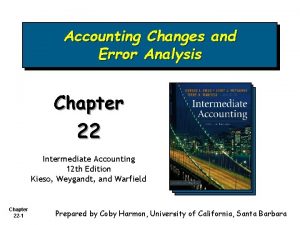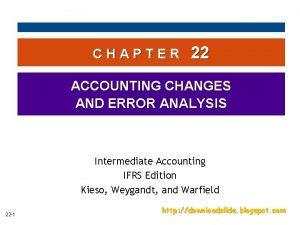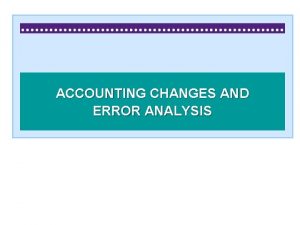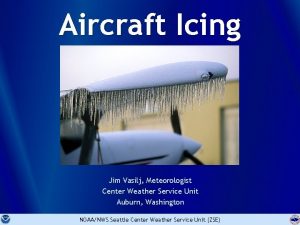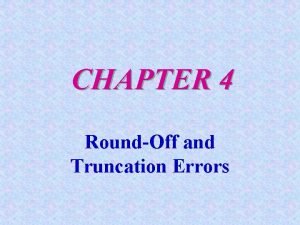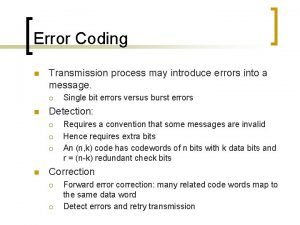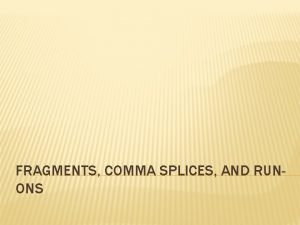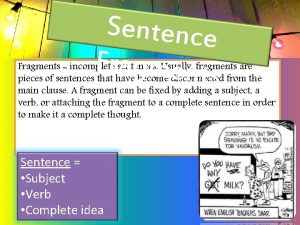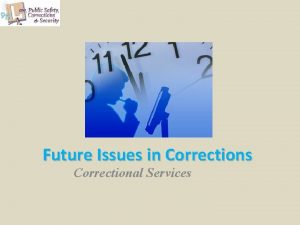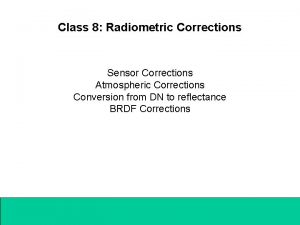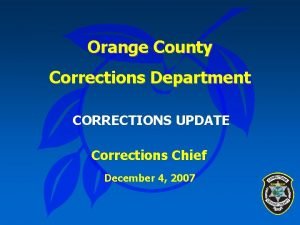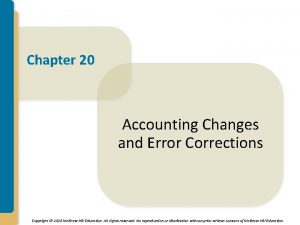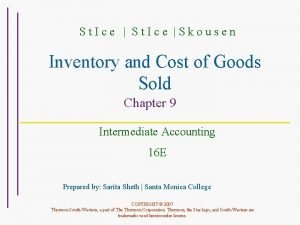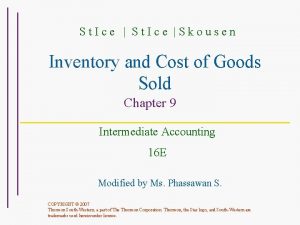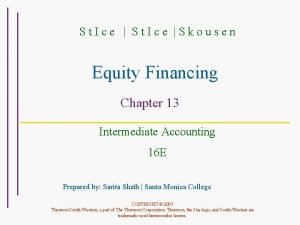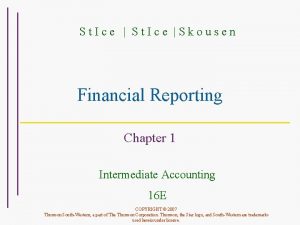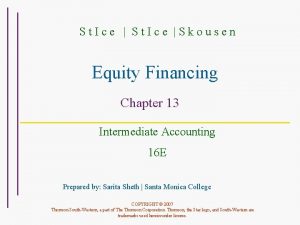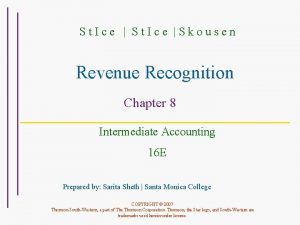St Ice Skousen Accounting Changes and Error Corrections


















- Slides: 18

St. Ice |Skousen Accounting Changes and Error Corrections Chapter 20 Intermediate Accounting 16 E Prepared by: Sarita Sheth | Santa Monica College COPYRIGHT © 2007 Thomson South-Western, a part of The Thomson Corporation. Thomson, the Star logo, and South-Western are trademarks used herein under license.

Learning Objectives 1. Understand the two different types of accounting changes that have been identified by accounting standard setters. 2. Recognize the difference between a change in accounting estimate and a change in accounting principle, and know how a change in accounting estimate is reflected in the financial statements. 3. Prepare the retrospective adjustment of prior periods’ financial statements, and any necessary cumulative adjustment, associated with a change in accounting principle.

Learning Objectives 4. Report pro forma results for prior years following a business combination. 5. Recognize the various types of errors that can occur in the accounting process understand when errors counterbalance, and be able to correct errors when necessary.

Accounting Changes • 1. 2. • Two main categories of accounting changes: Change in accounting estimate Change in accounting principle Basic issue is if the changes should be reported as adjustments of the prior periods statements or only affect current and future years.

Change in Accounting Estimate • Accounting information can not be measured precisely. • Estimates may need to be revised to give a better reflection of the business’s activities. • Examples accounting estimate changes: – – – Uncollectible receivables Useful lives of depreciation Residual values of depreciable assets Warranty obligations Quantities of mineral reserves to be depleted

Change in Accounting Estimate All changes in estimates should be reflected either in the current period or in current and future periods. No retroactive adjustments or pro forma statements are to be prepared for a change in estimate.

Change in Accounting Principle • A change in accounting principle involves a change from one generally accepted principle or method to another. • A change from a principle that is not generally accepted to one that is generally accepted is considered to be an error correction rather than a change in accounting principle.

Change in Accounting Principle • Report current year’s income components on the new basis. • Report the cumulative effect of the adjustment, net of tax, on the income statement. • Present prior period financial statements as previously reported. • Include pro-forma information as if the change were retroactive—direct and indirect effects. • Present earnings per share data for all prior periods presented.

Restatement for Prior Periods for Change in Principle • A change from LIFO method of inventory pricing to another method. • A change in the method of accounting for long-term construction contracts. • A change to or from the full cost method of accounting used in extractive industries. • Changes made at the time of an initial distribution of company stock. • A change from retirement-replacement-betterment accounting to depreciation accounting for railroads.

Restatement for Prior Periods for Change in Principle • Change to LIFO—past records often inadequate to prepare proformas. • Beginning inventory becomes first LIFO layer. • No cumulative effect adjustment is required.

Error Corrections Errors discovered currently in the course of normal accounting procedures. • Math errors • Posting to the wrong account • Misstating an account • Omitting an account from the trial balance

Error Corrections Errors limited to balance sheet accounts. • Debiting Accounts Receivable instead of Notes Receivable • Crediting Interest Payable instead of Notes Payable • Debiting an investment account instead of Land when property was purchased for plant expansion

Error Corrections Errors limited to income statement accounts. • Debiting Office Salaries instead of Sales Salaries • Crediting Rent Revenue instead of Commissions Revenue

Error Corrections Errors affecting both income statement accounts and balance sheet accounts. • Debiting Office Equipment instead of Repairs Expense • Crediting Depreciation Expense instead of Accumulated Depreciation

Error Corrections Errors affecting both income statement accounts and balance sheet accounts. • Debiting Office Equipment instead of Repairs Expense • Crediting Depreciation Expense instead of Accumulated Depreciation

Error Corrections Errors affecting both income statement accounts and balance sheet accounts. • There are errors in net income that, when not detected, are not automatically counterbalanced in the following fiscal period. • There also errors in net income that, when not detected, are not automatically counterbalanced in the following fiscal period: • Recognition of capital expenditures as expenses. • The omission of charges for depreciation and amortization.

Error Corrections • If detected in current period, before books are closed: – Correct the account through normal accounting adjustment. • If detected in subsequent period, after books are closed: – adjust financial records for effect of material errors. – make adjustment directly to Retained Earnings.

Required Disclosure for Error Restatements • If comparative statements are provided, apply correction retroactively to prior years. • Restate beginning balance of Retained Earnings for first period presented if error extends beyond. • Disclose and explain error correction in notes.
 Accounting changes and error corrections
Accounting changes and error corrections Chapter 22 accounting changes and error analysis
Chapter 22 accounting changes and error analysis Counterbalancing example
Counterbalancing example Change in accounting principle retrospective
Change in accounting principle retrospective Elizabeth mulroney
Elizabeth mulroney What is physical change and chemical change
What is physical change and chemical change Nick czernkovich
Nick czernkovich Clear ice vs rime ice
Clear ice vs rime ice Type i error
Type i error Types of random error
Types of random error Round off error
Round off error Crc example
Crc example Define absolute error
Define absolute error Corrections criminal justice
Corrections criminal justice Comma splice examples and corrections
Comma splice examples and corrections Which of the following is a sentence fragment marina
Which of the following is a sentence fragment marina Closed channel thinking
Closed channel thinking Law public safety corrections and security answer key
Law public safety corrections and security answer key Current and future issues in corrections
Current and future issues in corrections

